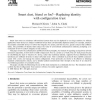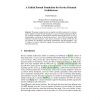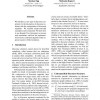91 search results - page 4 / 19 » How to Complete an Interactive Configuration Process |
CN
2004
13 years 7 months ago
2004
Smart dust motes are miniature self-contained systems that may be deployed in very large numbers. In military applications these devices are subject to different threats than conv...
AGENTS
1997
Springer
13 years 11 months ago
1997
Springer
We have been developing Rogue, an architecture that integrates high-level planning with a low-level executing robotic agent. Rogue is designed as the oce gofer task planner for X...
EMISA
2006
Springer
13 years 11 months ago
2006
Springer
: This paper summarizes how an algebra for mobile systems, the -calculus, can be applied as unified formal foundation to service oriented architectures (SOA). The concepts accounte...
COLING
2008
13 years 9 months ago
2008
We introduce a new type of discourse constraints for the interaction of discourse relations with the configuration of discourse segments. We examine corpus-extracted examples as s...
TOPNOC
2008
13 years 7 months ago
2008
Message Sequence Charts (MSCs) are a well known language for specifying scenarios that describe how different actors (e.g., system components, people, or organizations) interact. M...



